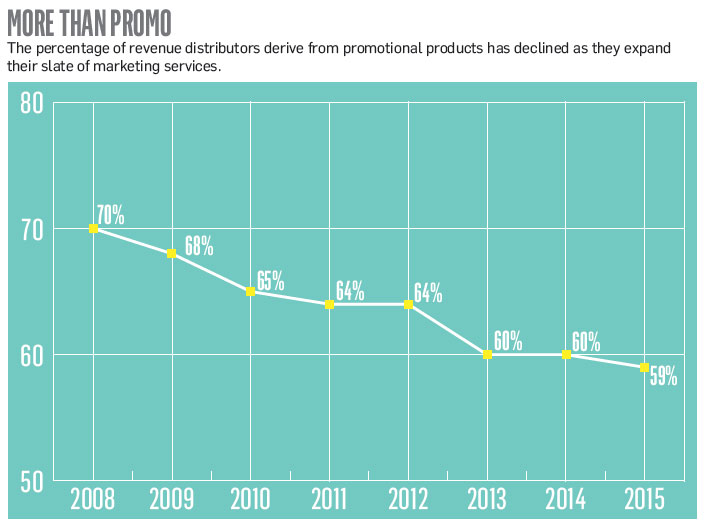Awards August 03, 2016
How to Grow Beyond Promo Products
With less revenue coming from promo, distributors must meet demands for additional services.
Accolades Inc. (asi/102910) has received more requests for services beyond promotional products, including fulfillment and gift wrapping. The services represent a minor additional revenue stream, something the distributor doesn’t market but won’t say no to when asked.

But Daryll H. Griffin, Accolades’ founder and CEO, recognizes her company needs to do more. Accommodating additional requests is too strenuous right now for the six-person company, but Griffin realizes the evolution of the promotional products industry, and she says her company will eventually transition into a full-service marketing agency in order to remain competitive. “We want to be a true partner to our clients,” she says, “and in order to do that, we’ll have to become, and I hate this phrase, a one-stop shop.”
What seems like an unusual path – promotional product companies selling less promotional products – is quickly becoming more common in the industry. In 2008, distributors averaged 70% of their revenue from promotional products. Last year, that total was 59%. One clear reason for the decline: the percentage of clients seeking services in addition to promotional products has been on the rise since 2013, primarily reported by larger distributors.
The rationale for offering a passel of additional services is compelling: capture more revenue from existing customers and guarantee you won’t have to turn them away. How that’s accomplished, however, will vary by distributor.
Ben Guez, founder of digital marketing firm LAXIR, advises against adding in-house resources to offer additional options. “It’s not the core of their business,” Guez says. “But distributors do have to partner up with specialist agencies so they can offer services to their clients.”
But, that approach can have limitations. Griffin’s graphic designer, for example, is currently outsourced. When it comes to rush orders or quick turnarounds, it’s not definite that the designer will be able to complete the order on time. If the designer worked in-house, however, Griffin says she’d feel more confident in accepting all of those rush orders. “We as a company can’t really grow unless we bring in the right number of people to grow together,” Griffin says.

Click here for a larger image of the above infographic
Top 40 distributor Geiger (asi/202900) has added e-commerce technology with great success. Gary Biron, vice president of vendor relations and marketing at the company, says the fastest growing part of Geiger’s business has been its online company stores division. “We have seen significant growth by offering completely custom online stores for our customers,” Biron says. “And while that requires more in-house resources, it does generate significant promotional product sales.”
One distributor has already become a full-service marketing agency: The Augusta Group, through its February merger with Mauk Advertising (asi/264380).
The Augusta Group offers a variety of print options such as business cards, letterheads, brochures, and even digital printing, which Managing Partner Chuck Porter says accounts for a large percentage of its business. The company also offers warehouse fulfillment, contacts for creative services and e-commerce store management. “If you want to grow, you better become a marketing agency,” Porter says. “If clients can get it all under one roof, it makes their life much easier.”
It’s certainly made a difference for the company, as sales in the first quarter of 2016 have been up 40% as compared to the first quarter of 2015. Coincidentally, Porter adds, so have the requests for additional services. “If you’re just pushing products, you’re like 90% of everyone else,” Porter says. “You have to be a solutions-driven company.”
Josh Frey, founder of On Sale Promos and The Swag Coach, sees the appeal of transitioning into a marketing agency, but believes it’s too risky for the unprepared. “Know the game you’re playing to protect your current assets and your future relationships,” Frey says. “If you don’t do your homework, you may not only waste your time, but also risk losing your company’s credibility.”

Frey says he’ll target the areas he’s comfortable with; for example, offering print or signage for his uniform clients, which is closely connected to his company’s current business. But creating ad campaigns from scratch is admittedly outside of his wheelhouse.
Rather than branching out into the advertising landscape, Frey says distributors can build their margins or even turn a profit by benefitting from basic services already offered, such as marking up shipping and handling or charging to recreate a client’s artwork. “It may not take a transition of service, but may take a shift of the sales pitch,” Frey says. “All distributors should be asking themselves, ‘what is my client’s job and what are all the things that I can sell him?’”
